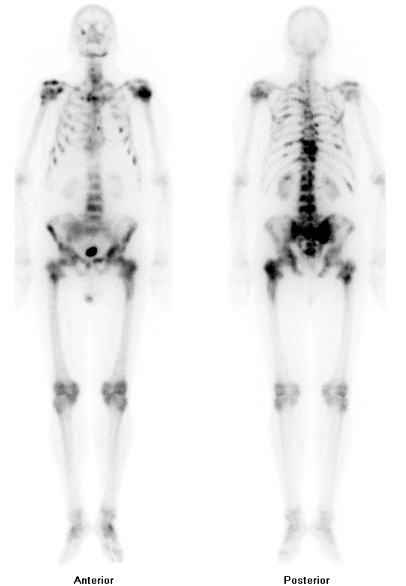Prostate cancer other imaging findings
Jump to navigation
Jump to search
Editor-In-Chief: C. Michael Gibson, M.S., M.D. [1] Associate Editor(s)-in-Chief: Syed Musadiq Ali M.B.B.S.[2]
|
Prostate cancer Microchapters |
|
Diagnosis |
|---|
|
Treatment |
|
Case Studies |
|
Prostate cancer other imaging findings On the Web |
|
American Roentgen Ray Society Images of Prostate cancer other imaging findings |
|
Risk calculators and risk factors for Prostate cancer other imaging findings |
Overview
Radionuclide may be helpful in the diagnosis of bone metastasis of prostate cancer.
Other Imaging Findings
- A Radionuclide uses bone-seeking radioactive materials (radiopharmaceuticals) and a computer to create a picture of the bones. It may be helpful in the diagnosis of bone metastasis of prostate cancer. [1]
- Indications of using radionuclide imaging include:
- Test results suggest an involvement of bone, such as increased alkaline phosphatase or calcium level
- Unexplained bone pain in men
PET SCAN
- PET scan has emerged as a promising staging modality for both primary and recurrent prostate cancer.
- Newer tracers have increased detection accuracies for small, incipient metastatic foci. The clinical implications of these occult PET/CT detected disease foci require organized evaluation.
- A classical positron emission tomography (PET scan) 18-F-fluorodeoxyglucose (FDG) is of limited utility in the management of prostate cancer, as the uptake of FDG in prostate cancer is highly variable.
- Early studies suggest that 18-fluorine-labeled choline, 18-F sodium fluoride, fluciclovine F-18, and 11-carbon-labeled acetate may be better tracers for use in recurrent prostate cancer. Currently, the use of these tracers is considered investigational.[2]

References
- ↑ Diagnosing prostate cancer.2015 Canadian Cancer Society. http://www.cancer.ca/en/cancer-information/cancer-type/prostate/diagnosis/?region=ab#Bone_scan
- ↑ Li R, Ravizzini GC, Gorin MA, Maurer T, Eiber M, Cooperberg MR, Alemozzaffar M, Tollefson MK, Delacroix SE, Chapin BF (April 2018). "The use of PET/CT in prostate cancer". Prostate Cancer Prostatic Dis. 21 (1): 4–21. doi:10.1038/s41391-017-0007-8. PMID 29230009.